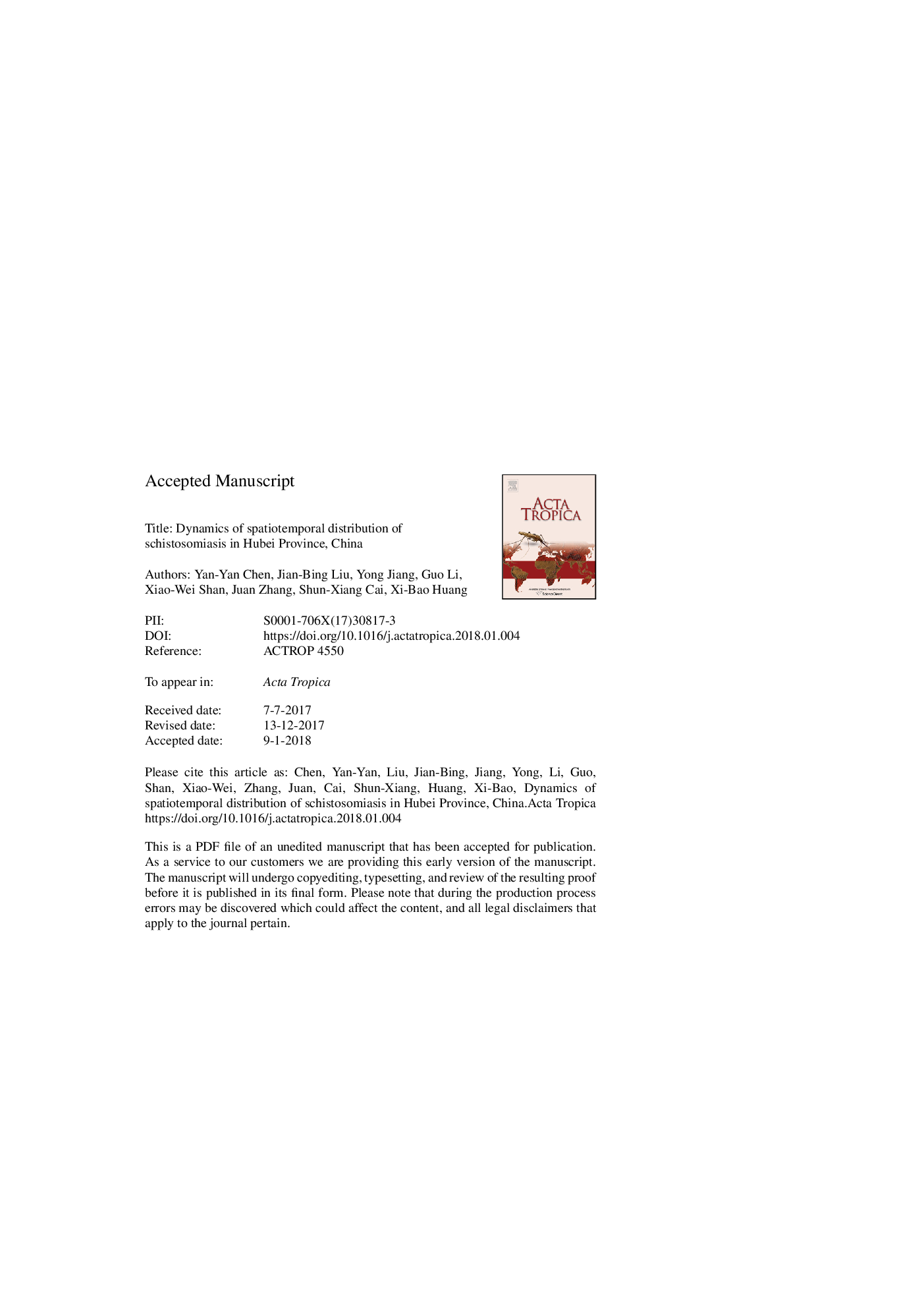| کد مقاله | کد نشریه | سال انتشار | مقاله انگلیسی | نسخه تمام متن |
|---|---|---|---|---|
| 8744390 | 1592744 | 2018 | 36 صفحه PDF | دانلود رایگان |
عنوان انگلیسی مقاله ISI
Dynamics of spatiotemporal distribution of schistosomiasis in Hubei Province, China
ترجمه فارسی عنوان
دینامیک توزیع فضایی طولی شیستوزومیایس در استان هوبئی، چین
دانلود مقاله + سفارش ترجمه
دانلود مقاله ISI انگلیسی
رایگان برای ایرانیان
موضوعات مرتبط
علوم زیستی و بیوفناوری
ایمنی شناسی و میکروب شناسی
انگل شناسی
چکیده انگلیسی
Schistosomiasis caused by parasitic flatworms of blood flukes, remains a major public health concern in China. The significant progress in controlling schistosomiasis in China over the past decades has resulted in the remarkable reduction in the prevalence and intensity of Schistosoma japonicum infection to an extremely low level. Therefore, the elimination of schistosomiasis has been promoted by the Chinese national government. Hubei Province is the major endemic area, that is, along the middle and low reaches of the Yangtze River in the lake and marshland regions of southern China. Eliminating the transmission of schistosomiasis in Hubei Province is challenging. The current issue is to determine the distributions and clusters of schistosomiasis transmission. In this study, we assessed the spatial distribution of schistosomiasis and the risk at the county level in Hubei Province from 2011 to 2015 to provide guidance on the elimination of schistosomiasis transmission in lake and marshland regions. Spatial database of human S.japonicum infection from 2011 to 2015 at the county level in the study area was built based on the annual schistosomias is surveillance data. Moran's I, the global spatial autocorrelation statistics, was utilized to describe the spatial autocorrelation of human S. japonicum infection. In addition, purely spatial scan statistics combined with space-time scan statistics were used to determine the epidemic clusters. Infection rates of S. japonicum decreased in each endemic county in Hubei from 2011 to 2015. Human S. japonicum infection rate showed statistical significance by global autocorrelation analysis during the study period (Moran's Iâ¯>â¯0, Pâ¯<â¯0.01). This result suggested that there were spatial clusters present in the distribution of S. japonicum infection for the five years. Purely spatial analysis of human S. japonicum infection showed one most likely cluster and one secondary cluster from 2011 to 2015, which covered four and one counties, respectively. Spatiotemporal clustering analysis determined one most likely cluster and one secondary cluster both in 2011-2012, which appeared in 4 and 5 counties, respectively. However, the number of clustering foci decreased with time, and no cluster was detected after 2013.The clustering foci were both located at the Jianghan Plain, along the middle reaches of the Yangtze River and its connecting branch Hanbei River. Spatial distribution of human S. japonicum infections did not change temporally at the county level in Hubei Province. A declining trend in spatiotemporal clustering was observed between 2011 and 2015. However, effective control strategies and integrated prevention should be continuously performed, especially at the Jianghan Plain area along the Yangtze and Hanbei River Basin. Multivariate statistical analysis was carried out to investigate the risk of missing examinations, missing treatment, and unstandardized treatment events. The results showed that age, education level and Sanitary latrines are risk factors for missing examinations (bâ¯>â¯0, ORâ>1), and treatment times in past and feeding cattle in village group are protective factors (bâ¯<â¯0, ORâ<1). We also found that age and education level are risk factors for missing treatment (bâ¯>â¯0, ORâ>1). Study of the risk for un-standardized treatment revealed that occupation is risk factors (bâ¯>â¯0, OR >1), though, education level is protective factors (bâ¯<â¯0, OR <1). Therefore, precise prevention and control should be mainly targeted at these special populations.
ناشر
Database: Elsevier - ScienceDirect (ساینس دایرکت)
Journal: Acta Tropica - Volume 180, April 2018, Pages 88-96
Journal: Acta Tropica - Volume 180, April 2018, Pages 88-96
نویسندگان
Yan-Yan Chen, Jian-Bing Liu, Yong Jiang, Guo Li, Xiao-Wei Shan, Juan Zhang, Shun-Xiang Cai, Xi-Bao Huang,
